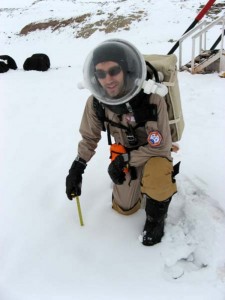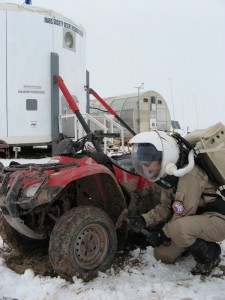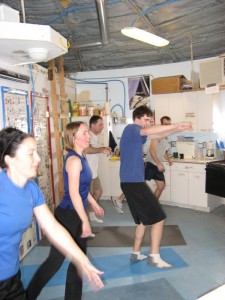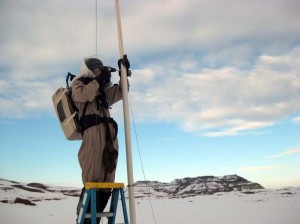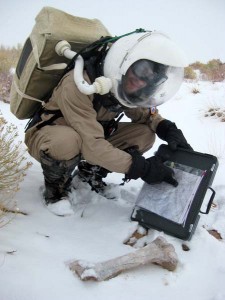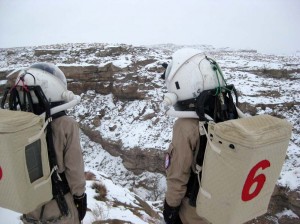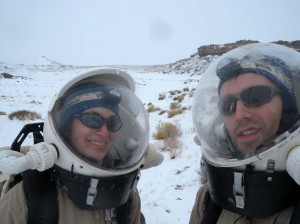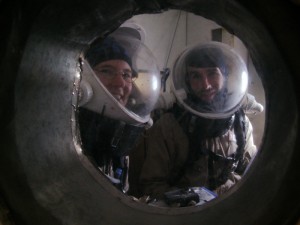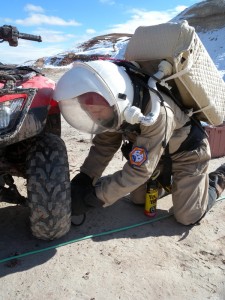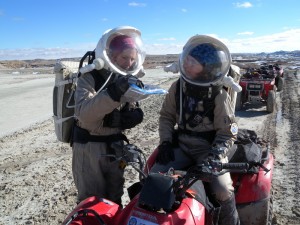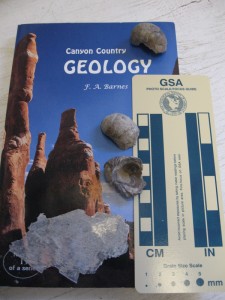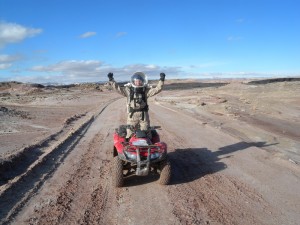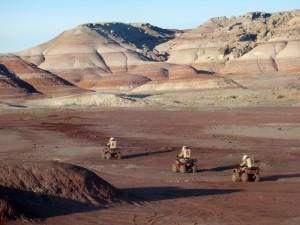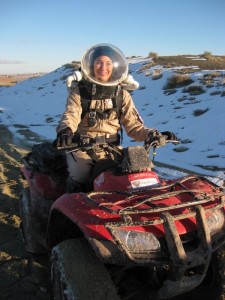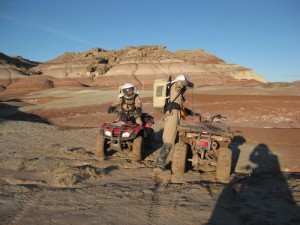The goal of this exercise is to live and work in a simulated Mars environment. But obviously we aren’t actually on Mars, and it is physically possible to go outside and breathe the atmosphere here (although it has been so cold that actually surviving the night outside the Hab would be challenging!). So during the mission, we distinguish between things done “in sim” (imposing constraints as if the outside environment were Mars) and “out of sim” (reverting to actual Earth constraints).
As you’d expect, we strive to do everything possible in sim. The day a new crew arrives is an exception, since there are 12 people (but only 6 suits) and a lot of information has to be conveyed in a short time, walking around to see and learn all of the systems. But after that, we are confined to our Hab, or going out in suits, aside from our “pressurized tunnels” that connects the Hab to the GreenHab (water recycling), “pressurized garage” where the ATVs live, the Musk Observatory, and the Engineering Station where the generators and fuel supplies are. These aren’t enclosed, but we pretend they are, since in a real landed mission the crew would likely have erected just such connections so that they could access those critical systems not actually in the Hab. The tunnels are delineated with rock-lined paths, so we are careful not to step outside of them.
But of course, staying in sim has its tedious downsides (that’s part of what you learn from this experience), like when you’re in your spacesuit and you get halfway through the 5-minute wait to “depressurize” the airlock, then remember that you forgot to grab the ATV keys. You could “break sim” to reach back inside and get the keys, or stay in sim and wait to repressurize the airlock, go inside, get the keys, return to the airlock, and wait to depressurize again. In this case, we opted to have another crew member run the keys outside (through the pressurized tunnel, to the pressurized ATV garage) and put them in the ATVs—since on Mars, we wouldn’t bother to bring the keys in and out with us. (It is incredibly remote here, but in theory it is possible for other people to wander down the road to the Hab and therefore the ATVs could be stolen, if we left the keys in them all the time.) But each such snag has to be worked through logically, to determine what would or would not be possible in a Martian environment, so that we can keep the simulation fidelity as high as possible.
So far we have opted in every such case, but one, to stay in sim, including two days ago when an EVA crew had to come back in and go through the pressurization/depressurization cycle to retrieve sunglasses (the snow was too bright!). As a result, EVA 7 became EVAs 7 and 8, and of course, this took up more time than planned.
The one exception to staying in sim was on EVA 8, when Carla’s helmet fogged up so much that she could not see where she was walking! After trying a variety of methods to deal with the condensation, she finally gave up and took off her helmet. In a real mission, she would probably have put her arm on another crew member’s shoulder and followed them, blind, back to the Hab. We had a good time joking about “dead” Carla, and considered holding a memorial session for her that night, but she declined. 🙂 Meanwhile, Brian’s helmet was just as fogged, but he was too darn stubborn to take it off!
This experience also got us thinking about other good exercises to conduct on EVA. What if a crew member were physically incapacitated and could not get back to the Hab under their own power, even being led? Previous crews have experimented with a fireman’s carry. We’ve decided to try a strategy based on our current weather conditions (3 inches of snow on the ground). I can hear some of the crew outside sawing and assembling a sled. We plan to have one EVA crew go out, get far enough to be out of line of sight, and then have a simulated accident in which one crew member cannot move. At that point they’ll radio back their GPS coordinates, and we’ll send a second crew out on the ATVs, with the sled, to rescue them. We’ll report back on this ambitious plan and what we learn from the attempt!
